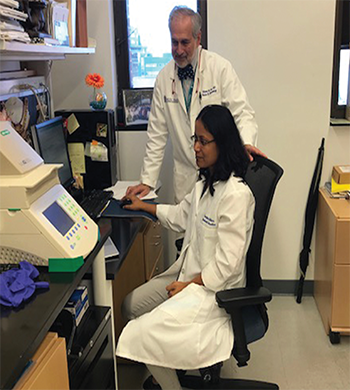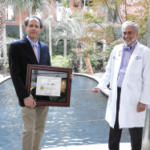Other Key Recruits

Dr. Silver reviews data with PhD candidate Tanjina Akter.
Following his interests in pediatric rheumatology, a passion developed by his time with Dr. Ansell prior to his UCSD fellowship, Dr. Silver had long treated children, as well as adults, at MUSC. He also wanted to establish a Division of Pediatric Rheumatology. He had been close to the family of Natasha Ruth, MD, since her teenage years, when he treated her mother for systemic sclerosis.
Indeed, Dr. Ruth says watching Dr. Silver with her mother and being introduced to rheumatologists at MUSC fostered her own interest in rheumatology. After medical school and a pediatric residency, she narrowed her choice to pediatric rheumatology and applied to train at Cincinnati Children’s Hospital Medical Center, where a recommendation letter from Dr. Silver to the late David Glass, MD, secured her fellowship and her future employment at MUSC. (Dr. Silver’s letter included the remark that Dr. Ruth would need her pediatric training since he had a job waiting for her if she were accepted for a fellowship.) Dr. Ruth says she accecpted the challenge of starting a new Division for Pediatric Rheumatology because she knew she would have the full support of Dr. Silver and his colleagues.
She also managed, with Dr. Silver’s help, to recruit her former mentor from Cincinnati, Murray Passo, MD, as well as Robert Warren, MD, PhD, MPH, and Mileka Gilbert, MD, PhD. The pediatric division became South Carolina’s first referral center for childhood rheumatic diseases.
Proudly, Dr. Silver says he has recruited another young physician for that division: his daughter, Kate Silver, MD, who holds a dual appointment in adult and pediatric rheumatology.
Funding Accelerates
The division established the South Carolina Inflammation and Fibrosis Center. This was funded by philanthropic contributions and a matching grant from the South Carolina SmartState Centers for Economic Excellence. (In 2002, the South Carolina General Assembly established the SmartState Program, funding it with proceeds from the South Carolina Education Lottery. The legislation authorizes the state’s three public research institutions—Clemson University, MUSC and the University of South Carolina—to use state lottery funds to create Centers of Economic Excellence in research areas that will advance South Carolina’s economy.) The philanthropic donations came first. When queried about his expertise in securing that funding, Dr. Silver attributes the donations, large and small, to grateful patients and long-lasting relationships.
Then, during application for the SmartState funding, he and his colleagues wrote their protocol noting the two diseases studied at MUSC, scleroderma and lupus, are marked by inflammation and fibrosis. They proposed, said Dr. Silver, that “We would use these two diseases that we have expertise in as prototypes for [researching] other major diseases with even greater morbidity, mortality and societal impacts.” That positioning strategy worked and resulted in the establishment of the center, as well as the endowed chairs for Drs. Tsao and Feghali-Bostwick.



